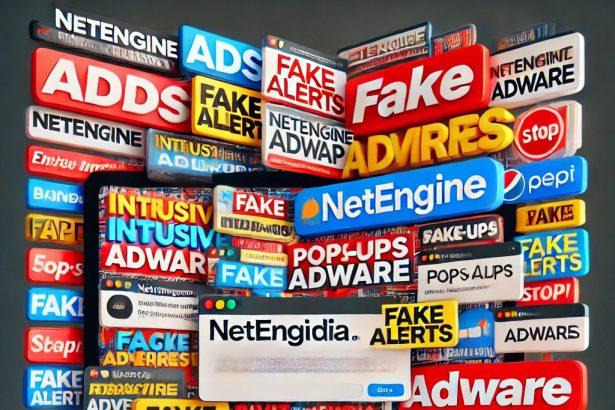Backstineseudis[.]com is a deceptive webpage known for tricking users into enabling push notification ads by impersonating a legitimate CAPTCHA check. This rogue site is part of a broader network of similar domains that abuse browser features to deliver intrusive pop-up ads, redirect users to unsafe content, and expose them to scams and malware.
Our cybersecurity researchers encountered backstineseudis[.]com while navigating suspicious websites affiliated with rogue advertising networks. Pages like this are rarely accessed directly; instead, they are opened through forced redirects or deceptive pop-ups on low-quality websites.
Once on the page, users are prompted to click “Allow” under the guise of verifying that they are not a robot. However, this is a trap. Clicking “Allow” authorizes the site to bombard the user with spammy and potentially harmful notifications. These ads often promote fake giveaways, scare tactics, dubious software downloads, and links to other shady or even dangerous domains.
Threat Summary
| Attribute | Details |
|---|---|
| Name | Ads by backstineseudis.com |
| Threat Type | Push notification adware, browser redirector, pop-up scam |
| Detection Names | Not available (N/A) on VirusTotal |
| Associated Emails | Not applicable |
| Symptoms | Intrusive pop-up ads, slowed browsing, browser redirects, unwanted tabs |
| Damage | Privacy breaches, exposure to scams, possible malware infections |
| Serving IP Address | 3.130.8.225 |
| Observed Subdomains | xn4iqv.backstineseudis.com, qwwnvw.backstineseudis.com, 0wvghk.backstineseudis.com, vjr2ws.backstineseudis.com, nze0xw.backstineseudis.com |
| Distribution Methods | Deceptive pop-ups, rogue ad networks, bundled with adware or PUAs |
| Danger Level | High – may lead to financial loss, identity theft, or system compromise |
Symptoms of Infection
If your device or browser is affected by the backstineseudis.com adware, you may notice:
- Ads popping up when you are not visiting the associated website
- A sudden surge in fake “system warning” messages or tech support scams
- New tabs or windows opening on their own
- Sluggish system performance and increased CPU usage
- Ads recommending suspicious tools or updates
Distribution Channels
Websites like backstineseudis.com usually spread via:
- Fake CAPTCHA verification prompts
- Redirects triggered by pirate streaming or adult content sites
- Malicious advertisements hosted on sketchy web platforms
- Potentially unwanted programs (PUPs) or browser hijackers bundled with free software
Manual Adware Removal Process (Windows & Mac)
Step 1: Identify and Uninstall Suspicious Applications
For Windows Users
- Open Task Manager by pressing
Ctrl + Shift + Esc. - Navigate to the “Processes” tab and search for unknown or high-resource-consuming processes.
- If you detect anything suspicious, right-click and select “End Task.”
- Go to
Control Panel>Programs>Programs and Features. - Locate and uninstall any unfamiliar programs.
For Mac Users
- Open
Finderand click onApplications. - Identify and move any suspicious applications to the
Trash. - Empty the
Trash. - Check
System Preferences>Users & Groups>Login Itemsfor unknown startup programs and remove them.
Step 2: Remove Malicious Browser Extensions
Google Chrome
- Open Chrome, click
Menu(three dots) >Extensions. - Locate and remove unknown extensions.
- Reset Chrome:
Settings>Reset settings> “Restore settings to their original defaults.”
Mozilla Firefox
- Click
Menu>Add-ons and themes. - Remove suspicious extensions.
- Reset Firefox:
Help>More troubleshooting information> “Refresh Firefox.”
Safari (Mac)
- Open Safari, go to
Preferences>Extensions. - Delete unknown extensions.
- Reset Safari:
History> “Clear History.”
Microsoft Edge
- Click
Menu>Extensions. - Remove any unfamiliar extensions.
- Reset Edge:
Settings>Reset settings> “Restore settings to their default values.”
Step 3: Delete Adware-Associated Files and Folders
For Windows Users
- Press
Win + R, type%AppData%, and press Enter. - Locate and delete suspicious folders.
- Repeat for
%LocalAppData%,%ProgramData%, and%Temp%.
For Mac Users
- Open Finder and press
Shift + Command + G, then enter~/Library/Application Support/. - Remove any suspicious folders.
- Repeat for
~/Library/LaunchAgents/,~/Library/LaunchDaemons/, and~/Library/Preferences/.
Step 4: Flush DNS Cache to Remove Adware Traces
For Windows Users
- Open
Command Promptas Administrator. - Type
ipconfig /flushdnsand press Enter.
For Mac Users
- Open
Terminal. - Enter
sudo killall -HUP mDNSResponderand press Enter.
Step 5: Restart Your System
Perform a reboot to apply the changes and ensure the removal process is complete.
Automatic Adware Removal Using SpyHunter (Windows & Mac)
For an effortless and effective solution, use SpyHunter, a powerful anti-malware tool designed to detect and remove adware completely.
Step 1: Download SpyHunter
Click the link to download SpyHunter: Download SpyHunter Here.
Step 2: Install SpyHunter
Follow the installation guide based on your operating system:
For Windows Users
- Run the downloaded
.exefile. - Follow the installation instructions.
- Launch SpyHunter and allow it to update its malware database.
For Mac Users
- Open the downloaded
.dmgfile. - Drag and drop SpyHunter into
Applications. - Open SpyHunter and let it update its database.
Step 3: Scan and Remove Adware
- Open SpyHunter.
- Click
Start Scan. - Wait for the scan to complete.
- Click
Fix Threatsto remove detected malware.
Step 4: Restart Your Computer
After SpyHunter removes all threats, restart your system to ensure all adware components are fully removed.
Conclusion
Backstineseudis[.]com is a textbook example of adware abuse via browser push notifications. It capitalizes on user confusion by mimicking legitimate verification prompts and uses rogue advertising networks to hijack browser sessions. Users who unknowingly interact with this threat may face a cascade of security issues, ranging from privacy violations to serious malware infections.
Avoid clicking suspicious “Allow” buttons, especially if prompted outside of trusted platforms. Recognizing these tricks is essential to protecting your system and personal data from long-term harm.




